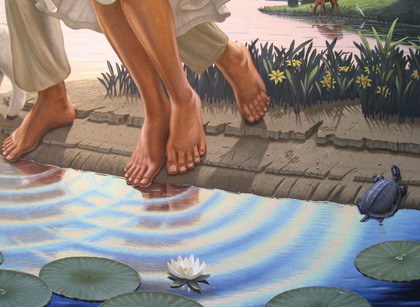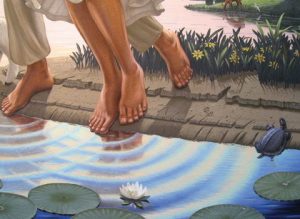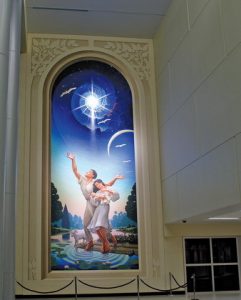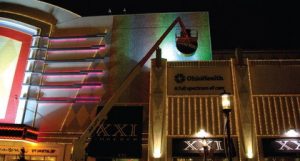Design
High Murals, Part One
The diverse faces and sizes of wall graphics
Published
15 years agoon

It’s approximately as difficult for a mural to be understated as it would be for a silverback gorilla to traipse delicately through your living room. Whether rendered by hand or via an inkjet printer, environmental graphics juxtaposed against blank walls almost invariably attract attention.
From the murals unearthed in southern France’s Lascaux caves, which were some of the earliest forms of art, to Mexico’s muralista movement, which generated colossal works from such luminaries as Diego Rivera, David Siqueiros and José Orozco, to modern commercial and public-art applications, the mural remains a vital art form.
Amidst economic triage and uncertainty, it can be increasingly difficult to convince would-be clients wary of their balance sheets to invest in grand-format graphics. However, the timeless maxim, “it takes money to make money,” remains unflinchingly true. Whether as a complement to on-premise advertising, an off-premise wall graphic or a stately piece of public art, murals offer a plethora of possibilities.
A Bountiful Beginning
Eric Grohe began his 44-year, artistic career as a graphic artist and illustrator, but has focused his creative energies on murals for the past two decades of his career. He’s received commissions nationwide, taught art and design classes worldwide and has won several awards for his gargantuan artwork (see ST, December 2002, page 82).
In the fall of 2007, the Florida Hospital of Orlando, a medical facility affiliated with the Adventist Health System, commissioned Grohe to create a mural for its new, state-of-the-art facility that opened in November in conjunction with the 100th anniversary of the hospital’s inception.
AdvertisementHospital officials initially approached Grohe during the facility’s early construction phase to discuss the creation of a large mural for the hospital’s lobby. He used Google Earth satellite photos of the site to develop a sense of the facility’s environs and orientation that helped him mesh his work with the building’s character gleaned from architectural renderings.
The foyer where the mural looms large measures 120 ft. deep, but an escalator descends roughly 30 ft. front of the adorned wall and provides a unique, panoramic view. He emphasized the foyer’s high ceiling in creating a 40-ft.-tall, 24-ft.-wide mural.
“When the hospital’s officials approached us, we didn’t ask them for a concept or an idea; we asked for their desired outcome,” Grohe said. “Because a hospital is a place that people often enter in a nervous or fearful state, they asked that my work convey a sense of tranquility, peace, confidence and joy.”
He created a model of the site to provide the client with a more definitive sense of the mural’s subjects – Grohe believes photographs or renderings can look “dead” and not convey the artwork’s potential depth. He also created an easel painting to convey his intended color palette and give the client a scaled-down version to more easily request color changes.
AdvertisementHe strived to render Orlando as it would’ve looked 100 years before – well before Orlando’s population explosion – and to convey the beauty of nature as described in the Genesis creation story. According to Grohe, all flora and fauna depicted were visible within a mile of the hospital grounds except for the lamb, which he photographed at an Orlando-area petting zoo. Grohe modeled the baby after a child of hospital staffersl. To create the mural’s celestial backdrop, he consulted a planetarium program that replicated how stars were positioned above the site on the morning of the hospital’s 1908 inception.
“I always make it clear to my clients that they should free express ideas or concerns, and not to worry about bruising my ego,” he said. “I’m there to create the best artwork I can and serve their needs.”
The mural required very vivid colors because the windows adjacent to the mural face west, which means sun doesn’t shine through until well into the afternoon. To provide optimal color retention and an environmentally sound product, Grohe selected Keim mineral-based paint.
“The pigment is made of finely ground minerals that have been oxidized and, therefore, will be immune to fading,” he said. “Also, because it’s not a petrochemical product, it doesn’t emit any VOCs and is much better for the facility’s air quality.”
To help develop the mural, Grohe hired an assistant artist, who painted large, solid-color areas with Shurline foam pads, for the first two months. Then, Grohe painted the central imagery using China bristle brushes that work ideally with paint’s viscosity. He said, “It’s a pleasure to work on freshly built plaster; you can practically hear the paint absorbing into the wall.”
A Healthy Wall Graphic
AdvertisementHistorically, murals have been perceived as a handpainted medium. Even as inkjet printers have grown in capacity, decreased in cost and incorporated increasingly versatile ink systems, digitally output murals have still remained flat. Orange Barrel Media, a Columbus, OH-based company that company president Pete Scantland describes as “half signshop and half media agency,” redefined the artform with this project installed as an out-of-home advertisement for OhioHealth, which operates several healthcare facilities throughout the Buckeye State. The company installed the sign on a wall outside Easton Mall, which many view as the city’s most upscale shopping center.
“Our business model differs from most signshops,” he said. “Like Clear Channel, we own several media spaces that we market to various advertisers.”
They convinced OhioHealth officials to buy the ad space to incorporate a 3-D graphic. Ohio Health subsequently enlisted Laine Gabriel, a Columbus-based ad agency, to develop the artwork.
“Ohio Health had bought ad space for some of its individual facilities, but this was the first time they’d purchased ad space that marketed its entire network,” Scantland said. “They wanted a large-format wall graphic that summarized their resources, and they wanted the dimension to attract extra attention.”
Instead of creating a backdrop or façade, Scantland opted to integrate the 2,500-sq.-ft. graphic into the wall using 3M’s Scotchcal™ 8624 textured-wall media. He said they initially considered dimensional appliqués for the surface, but thought a bejeweled appearance might appear odd and reconsidered. To apply the media, installers used heavy-duty heat guns to conform the substrate to the concrete background.
“Installing the backdrop was a very labor-intensive process,” Scantand said. “Four or five installers had to work two full overnights to install the wrap. To make the process more efficient, we mounted the heat guns to rollers.”
Orange Barrel contracted Vision Intl. (Salt Lake City, UT) to handle the vinyl’s printing. According to Steve Turner, Vision’s project manager, the shop output the substrate on an EFI-VUTEk 5330 grand-format printer and protected the film with 3M’s 8524 overlaminate that’s specifically engineered for the rough media.
Because the wall sits above a protruding façade, incorporation dimension proved vital. Orange Barrel fabricated drum-shaped, 10-ft.-diameter, 2-ft.-deep, aluminum cans. The company’s field managers, Michael Smith and Edward Cox, welded the pieces using a Miller aluminum spool gun . To decorate them, fabricated routed faces with 15-lb. Sign*Foam® HDU, which they fit onto aluminum sidewalls that encircled the drums. Then, they stretched 13-oz., digitally printed vinyl across the face. To make the installation appear seamless, installers fastened the cans with concealed brackets before installing the sidewalls. For dramatic effect, Orange Barrel installed a spotlight 30 ft. away that illuminates the wall sign nightly.
Not surprisingly, Scantland said the most intangible asset proved the greatest challenge – time: “We had two weeks from graphic approval to finish this project, as well as another Ohio Health installation at Polaris [another Columbus mall], so we essentially had one week for this project. Our whole staff had to work double overtime to finish this project in time for Black Friday, but the result is very satisfying.”

SPONSORED VIDEO
Introducing the Sign Industry Podcast
The Sign Industry Podcast is a platform for every sign person out there — from the old-timers who bent neon and hand-lettered boats to those venturing into new technologies — we want to get their stories out for everyone to hear. Come join us and listen to stories, learn tricks or techniques, and get insights of what’s to come. We are the world’s second oldest profession. The folks who started the world’s oldest profession needed a sign.
You may like

Michigan Residents Make Parodies of Viral Detroit City Sign

What Makes the Perfect Sign Business Partnership

Marketing Signs to Schools, Tradeshow and Quote Follow-up Make May’s List
Subscribe

Bulletins
Get the most important news and business ideas from Signs of the Times magazine's news bulletin.
Most Popular
-

 Photo Gallery2 weeks ago
Photo Gallery2 weeks ago30 Snapshots of the 2024 ISA Sign Expo
-

 Ask Signs of the Times2 weeks ago
Ask Signs of the Times2 weeks agoWhy Are Signs from Canva so Overloaded and Similar?
-

 Paula Fargo1 week ago
Paula Fargo1 week ago5 Reasons to Sell a Sign Company Plus 6 Options
-

 Real Deal5 days ago
Real Deal5 days agoA Woman Sign Company Owner Confronts a Sexist Wholesaler
-

 Photo Gallery1 week ago
Photo Gallery1 week ago21 Larry Albright Plasma Globes, Crackle Tubes and More
-

 Women in Signs2 weeks ago
Women in Signs2 weeks ago2024 Women in Signs: Brandi Pulliam Blanton
-

 Women in Signs2 weeks ago
Women in Signs2 weeks ago2024 Women in Signs: Alicia Brothers
-

 Projects5 days ago
Projects5 days agoGraphics Turn an Eyesore Cooler Into a Showpiece Promo in Historic Plaza











